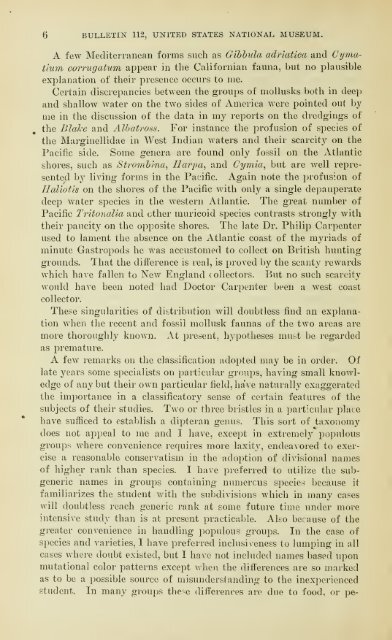United States National Museum - si-pddr - Smithsonian Institution
United States National Museum - si-pddr - Smithsonian Institution
United States National Museum - si-pddr - Smithsonian Institution
You also want an ePaper? Increase the reach of your titles
YUMPU automatically turns print PDFs into web optimized ePapers that Google loves.
6 BULLETIN 112, UNITED STATES NATIONAL MUSEUM.<br />
A few Mediterranean forms such as Gibbula adriatica and C'ymatium<br />
corrugatum appear in the Californian fauna, but no plau<strong>si</strong>ble<br />
explanation of their presence occurs to me.<br />
Certain discrepancies between the groups of mollusks both in deep<br />
and shallow water on the two <strong>si</strong>des of America were pointed out by<br />
me in the discus<strong>si</strong>on of the data in my reports on the dredgings of<br />
the Blake and Albatross. For instance the profu<strong>si</strong>on of species of<br />
the Marginellidae in West Indian waters and their scarcity on the<br />
Pacific <strong>si</strong>de. Some genera are found only fos<strong>si</strong>l on the Atlantic<br />
shores, such as Strombina, Harpa, and Cymia, but are well repre-<br />
sented by living forms in the Pacific. Again note the profu<strong>si</strong>on of<br />
Haliotis on the shores of the Pacific with only a <strong>si</strong>ngle depauperate<br />
deep water species in the western Atlantic. The great number of<br />
Pacific Tritonalia and other muricoid species contrasts strongly with<br />
their paucity on the oppo<strong>si</strong>te shores. The late Dr. Philip Carpenter<br />
used to lament the absence on the Atlantic coast of the myriads of<br />
minute Gastropods he was accustomed to collect on British hunting<br />
grounds. That the difference is real, is proved by the scanty rewards<br />
which have fallen to New England collectors. But no such scarcity<br />
would have been noted had Doctor Carpenter been a west coast<br />
collector.<br />
These <strong>si</strong>ngularities of distribution will doubtless find an explana-<br />
tion when the recent and fos<strong>si</strong>l mollusk faunas of the two areas are<br />
more thoroughly known. At present, hypotheses must be regarded<br />
as premature.<br />
A few remarks on the clas<strong>si</strong>fication adopted may be in order. Of<br />
late years some specialists on particular groups, having small knowl-<br />
edge of any but their own particular field, have naturally exaggerated<br />
the importance in a clas<strong>si</strong>ficatory sense of certain features of the<br />
subjects of their studies. Two or three bristles in a particular place<br />
have sufficed to establish a dipteran genus. This sort of taxonomy<br />
does not appeal to me and I have, except in extremely populous<br />
groups where convenience requires more laxity, endeavored to exercise<br />
a reasonable conservatism in the adoption of divi<strong>si</strong>onal names<br />
of higher rank than species. I have preferred to utilize the sub-<br />
generic names in groups containing numerous species because it<br />
familiarizes the student with the subdivi<strong>si</strong>ons Avhich in many cases<br />
will doubtless reach generic rank at some future time under more<br />
inten<strong>si</strong>ve study than is at present practicable. Also because of the<br />
greater convenience in handling populous groups. In the case of<br />
species and varieties, I have preferred inclu<strong>si</strong>veness to lumping in all<br />
cases where doubt existed, but I have not included names based upon<br />
mutational color patterns except when the differences are so marked<br />
as to be a pos<strong>si</strong>ble source of misunderstanding to the inexperienced<br />
student. In many groups these differences are due to food, or pe-

















